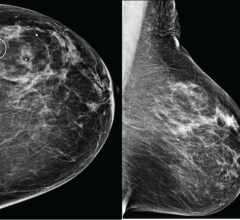
Dave Fornell is the editor of Diagnostic & Interventional Cardiology magazine and assistant editor for Imaging Technology News magazine.
Trends in Cardiovascular CT Imaging

An example of FFR-CT, which uses supercomputing algorithms to determine a virtual assessment of hemodynamic flow through all coronary artery segments.
Here is a recap of some of the top trends and new technology at the Society of Cardiovascular Computed Tomography (SCCT) 2015 annual meeting in Las Vegas.
Watch video Editor’s Choice of the Most Innovative News Technology at SCCT 2015
Watch video on key trends from the SCCT President
Last November, the U.S. Food and Drug Administration (FDA) cleared the use of fractional flow reserve-CT (FFR-CT) software used to noninvasively virtually assess the blood flow through plaque narrowings of coronary vessels to see if the lesions have any hemodynamic significance. This may eliminate the need to perform invasive FFR readings in the cath lab, since the FFR-CT has a close correlation with the catheter-based technology. Catheter FFR is currently the gold standard for assessing the functional significance of lesions and to justify the need for stents. FFR-CT is viewed by many luminaries at SCCT as a potential paradigm shift in how chest pain and cardiac patients will be assessed in the future. This technology was definitely the poster child for SCCT 2015, and the subject of numerous packed sessions.
Watch a video interview on FFR-CT
CT perfusion imaging was also a big topic of discussion, with numerous clinical trials now showing it can offer a more accurate functional assessment of blood flow in the heart without the need for a nuclear exam, stress testing or MRI.
New clinical trial data continue to show the accuracy of patient risk stratification of coronary artery calcium scoring from CT exams. There appeared to be a renewed interest in calcium scoring assessments, which could be used similar to regular mammography exams to monitor cardiovascular disease risk. Data suggest a CT showing no calcium in the coronaries provides a patient with a clean bill of health for at least seven years. Regularly scheduled calcium scans could be used to determine if patients need to be prescribed statins and to monitor non-symptomatic patients with a family history of coronary disease. SCCT also is developing a radiology RADS risk scoring system similar to BI-RADS for breasts or LUNG-RADS for lung cancer assessments to facilitate this type of screening in the future.
Watch a video explaining how calcium scoring may add value to healthcare
Cardiac CT has become the gold standard imaging modality for assessing patients for transcatheter aortic valve replacement (TAVR). The CT images also are used for planning treatment, valve sizing, and both multiplanar and 3-D CT images are used to help guide the procedures. TAVR and CT’s roll with increasingly more complex transcatheter structural heart interventions was a major topic of discussion in sessions and on the expo floor. Edward’s Life Sciences, maker of the Sapien TAVR device, exhibited for the first time this CT specialty meeting, driving home the fact that these devices and imaging technologies go hand-in-hand.
Other big topics of discussion included the use of CT as a first line assessment to rule out coronary disease with chest pain patients in the emergency department, the utility of spectral CT imaging and 3-D printing.
Video on the use of CT to assess ED chest pain patients
Video on how 3-D cardiac printing is used at Henry Ford Hospital


 December 03, 2025
December 03, 2025 









